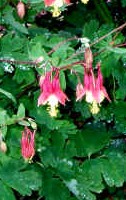 Native to Eastern US where it grows in moist shady sites, wild columbine is a herbaceous perennial and a member of the buttercup family, Ranunculaceae, that also includes clematis, delphinium, and hellebores. The leaves are three inches long, form attractive mounds, and are biternate with deep lobed leaflets. The unique flowers are nodding, one to two inches long, and feature straight red petal-like sepals, and yellow petals with medium length red nectar spurs. The spurs are slightly curved and lack hooks. The anthers of the stamens are yellow and exerted. Plants begin blooming in late spring and continue for about a month. They reseed and can form colonies. Unlike many other species of columbine, the foliage of wild columbine is resistant to leaf minors. It is an excellent choice for cottage, woodland, and wild flower gardens with the bonus of attracting hummingbirds and butterflies. The genus name, Aquilegia, comes from the Latin word aquila meaning eagle and perhaps refers to the resemblance of the spurs to the talons of an eagle.
Native to Eastern US where it grows in moist shady sites, wild columbine is a herbaceous perennial and a member of the buttercup family, Ranunculaceae, that also includes clematis, delphinium, and hellebores. The leaves are three inches long, form attractive mounds, and are biternate with deep lobed leaflets. The unique flowers are nodding, one to two inches long, and feature straight red petal-like sepals, and yellow petals with medium length red nectar spurs. The spurs are slightly curved and lack hooks. The anthers of the stamens are yellow and exerted. Plants begin blooming in late spring and continue for about a month. They reseed and can form colonies. Unlike many other species of columbine, the foliage of wild columbine is resistant to leaf minors. It is an excellent choice for cottage, woodland, and wild flower gardens with the bonus of attracting hummingbirds and butterflies. The genus name, Aquilegia, comes from the Latin word aquila meaning eagle and perhaps refers to the resemblance of the spurs to the talons of an eagle.
Type: Herbaceous perennial
Bloom: Yellow and red nodding flowers 1-2 inches long for a long bloom-time beginning in spring
Size: 2-3’
Light: Light to partial shade; tolerates full sun in cool climates.
Soil: Average to fertile, medium moist, well-drained
Hardiness: Zones 3-8
Care: Cut back foliage in mid summer if it declines.
Pests and Diseases: More resistant to leaf minor than most other columbines
Propagation: Fresh seed or stratified older seed
Companion Plants: Foam flowers, Siberian iris, Heuchera, ferns
·
Outstanding Selections: ‘Corbett’ (Light yellow flowers)